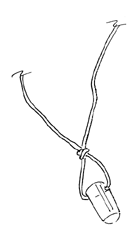PURPOSE
- To identify types of tracheostomy tubes/appliances.
DESCRIPTION
- Tracheostomy and laryngectomy tubes vary in size, degree of arc, and length.
- The 3 parts of the tracheostomy tube may or may not be interchangeable with another tube of the same size/type.
- The outer cannula (Fig. V.B.3.1) fits directly into the tracheal stoma. Proximal flange designs vary to accommodate mechanisms for securing the tube in place and/or locking the inner cannula. The distal end of the outer cannula may or may not incorporate a cuff that, when inflated, prevents air leakage between the tracheal wall and outside of the tracheostomy tube. This seal facilitates ventilatory assistance and/or minimizes aspiration. Tracheostomy tube cannulae may be fenestrated along the greater curvature to allow for air passage through the tube and upward toward the pharynx. Such fenestra are utilized for speech production and/or preparation for decannulation.
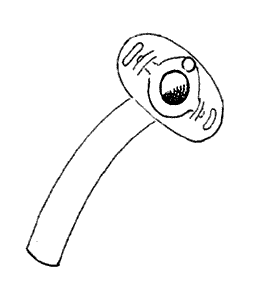
The obturator (Fig. V.B.3.2) is inserted into the outer cannula to facilitate insertion into the trachea. Because the obturator occludes the lumen of the tracheostomy tube and therefore the patient's airway, it is immediately removed after the outer cannula is in its proper location. The obturator should be kept readily available for reinsertion in the event of tracheostomy tube displacement. It should always accompany the patient (eg, to x-ray, OR).
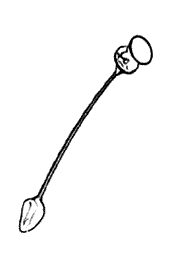
The inner cannula (Fig. V.B.3.3) is inserted into the outer cannulae and locked into place. Locking mechanisms vary, and the inner cannula may or may not incorporate a 15 mm adaptor (Fig. V.B.3.4) for use with ventilatory equipment (ie, ventilation bag, ventilator tubing). Nondisposable inner cannulae should only be removed for cleaning. Not all types of tracheostomy tubes have inner cannula.
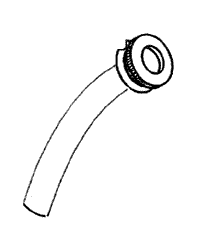

Types of tubes and appliances:
- Jackson (plain) Tracheostomy Tube: This stainless steel tube does not have a cuff or 15 mm adaptor. Available in sizes 00 through 10.
- Lorae Tracheostomy Tube: Identical to Jackson tube except that inner cannula has a 15 mm adaptor.
- Shiley Low Pressure Cuffed Tracheostomy Tube (Fig. V.B.3.5): This cuffed plastic tube has locking inner cannula with 15 mm adaptor. It is available in even sizes 4, 6, 8, and 10.
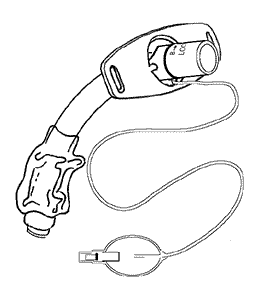
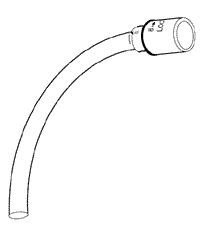

Fenestrated tracheostomy tubes:
- Shiley Fenestrated Low Pressure Cuffed Tracheostomy Tube: This tracheostomy tube has a fenestrated outer cannula (Fig. V.B.3.6) and 2 inner cannulae. The longer of the 2 cannulae (Fig. V.B.3.7) has a 15 mm adaptor, is not fenestrated, and consequently occludes the fenestration in the outer cannula. The shorter red inner cannula (Fig. V.B.3.8) is called a decannulation cannula. It extends to just above the fenestration and occludes the proximal lumen of the outer cannula, requiring the patient to breathe through the fenestration up toward the pharynx. It is available in sizes 4, 6, and 8.
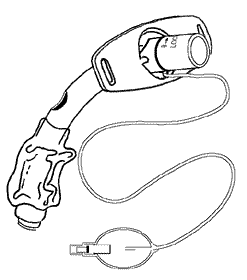
- Jackson Fenestrated Stainless Steel Tracheostomy Tube: Inspect the tube to ensure that the fenestration of the outer and inner cannulae match each other precisely for size and location. It is available in sizes 4 through 8.
- Shiley Cuffless Tracheostomy Tube: This plastic tracheostomy tube is available in sizes 4, 6, and 8. The tracheostomy tube has 3 inner cannulae with different connectors:
- Inner cannula with closed lumen and low profile connector intended for decannulation; never use this decannulation cannula in a cuffed tracheostomy tube
- Inner cannula with open lumen and low profile connector not intended for assisted ventilation
- Inner cannula with 15 mm adaptor
- Shiley Disposable Inner Cannula Low Pressure Cuffed Tracheostomy Tube: This is a polyvinyl chloride tube that has a disposable inner cannula with 15 mm adaptor. This inner cannula is intended for one-time usage and eliminates the need to clean the inner cannula. The locking mechanism differs from other Shiley styles, and therefore this inner cannula is not interchangeable with others.
- Shiley Pediatric and Neonatal Tubes (Fig. V.B.3.9): These plastic tubes (uncuffed and cuffed) do not have inner cannulae. The outer cannula has a 15 mm adaptor. Available in multiple sizes.

T-Adaptor (Fig. V.B.3.10): Plastic disposable adaptor will allow for release of carbon dioxide while administering oxygen per nebulizer. Attaches to standard 15 mm adaptors (Lorae, Shiley).
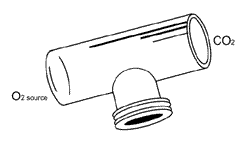
Omni-Flex Connector: Plastic flexible tubing/connector attaches to 15 mm adaptors. Provides flexibility decreasing tension on tracheostomy tube when attached to nebulizer tubing.
Blom-Singer Tracheostomy Vent (Fig. V.B.3.11): Silicone appliance used to prevent stenosis of laryngectomy stoma. May be worn with or without ties. Available in sizes 8, 9, and 10 in various lengths.
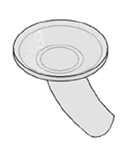
Tracheostomy Tube Cork (Fig. V.B.3.12): Used for decannulation preparation. Available in half or full cork in sizes 0 through 10 for use with Jackson tracheostomy tube. Secured with ties to patient's neck or to trach ties. Never place a cork in a cuffed tracheostomy tube.
